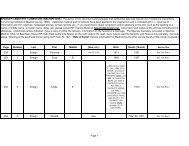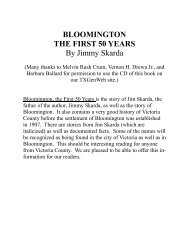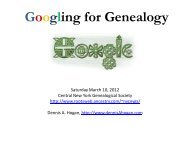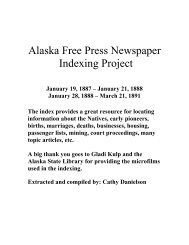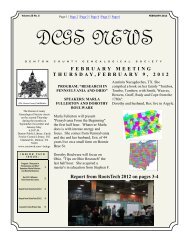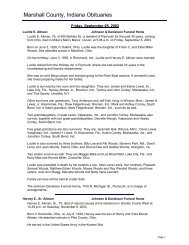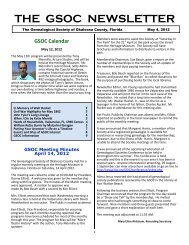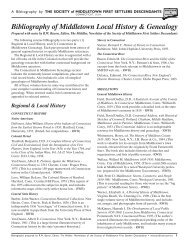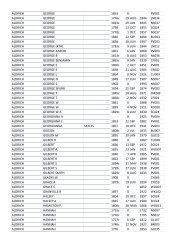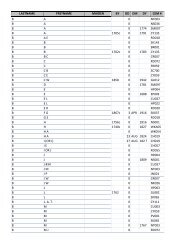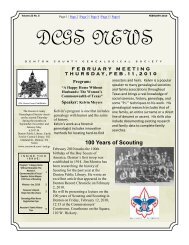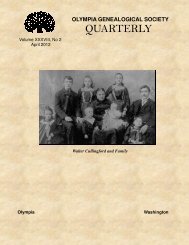Getting to the Roots of Your Family - RootsWeb - Ancestry.com
Getting to the Roots of Your Family - RootsWeb - Ancestry.com
Getting to the Roots of Your Family - RootsWeb - Ancestry.com
You also want an ePaper? Increase the reach of your titles
YUMPU automatically turns print PDFs into web optimized ePapers that Google loves.
• Register <strong>of</strong> <strong>the</strong> Great Seal 1306-1668, 11 vols. (FHL book 941 N2sc): 1306-1651 are available on<br />
<strong>Ancestry</strong> at http://search.ancestry.<strong>com</strong>/search/db.aspx?dbid=34544<br />
• Statistics <strong>of</strong> <strong>the</strong> annexed estates, 1755-1756: from <strong>the</strong> records <strong>of</strong> <strong>the</strong> forfeited estates preserved in <strong>the</strong> Scottish<br />
Record Office [NAS]. FHL Q book 941 R2sa. Lists tenants on <strong>the</strong> estates forfeited as a result <strong>of</strong> <strong>the</strong><br />
1745 Rebellion.<br />
• Index <strong>of</strong> Place Names <strong>to</strong> <strong>the</strong> Abridgements <strong>of</strong> Sasines (see that section)<br />
• Timperley, Loretta R. Direc<strong>to</strong>ry <strong>of</strong> Landownership in Scotland circa 1770. (FHL book 941 B4sr n.s. v. 5)<br />
• Return <strong>of</strong> Owners <strong>of</strong> Land and Heritages in Scotland 1872-73 (FHL Q book 941 R25i)<br />
• National Register <strong>of</strong> Archives (searchable online) www.nationalarchives.gov.uk/nra/<br />
Once you have determined <strong>the</strong> owner <strong>of</strong> land where your ances<strong>to</strong>r may have lived, search <strong>the</strong> NAS<br />
online catalogue for <strong>the</strong> owner’s name or <strong>the</strong> property name and <strong>the</strong> references <strong>of</strong> E, GD, or RH. Also<br />
look in <strong>the</strong> FHL catalog for <strong>the</strong> county where <strong>the</strong> property was located and <strong>the</strong> <strong>to</strong>pic <strong>of</strong> Land and<br />
Property.<br />
VALUATION ROLLS<br />
Valuation rolls are tax records based on land value. Valuation rolls exist sporadically before 1855 (<strong>the</strong><br />
Direc<strong>to</strong>ry <strong>of</strong> Landownership in Scotland circa 1770 is based in part on <strong>the</strong> rolls for that year). The Inland<br />
Revenue Service records (NAS catalogue reference IRS) include pre-1855 records for <strong>the</strong> counties <strong>of</strong><br />
Aberdeen, Ayr, Banff, Dumfries, Fife, Lanark, Midlothian and Edinburgh, Roxburgh and Stirling.<br />
Beginning in 1855 <strong>the</strong> records are <strong>com</strong>plete (except <strong>the</strong>y do not include <strong>the</strong> burghs) and are listed in <strong>the</strong><br />
NAS online catalog with <strong>the</strong> reference <strong>of</strong> VR. Learn more about <strong>the</strong>m at<br />
http://www.nas.gov.uk/guides/valuationRolls.asp. The FHL has only a few records. Look in <strong>the</strong> FHL<br />
catalog for a place <strong>of</strong> interest and <strong>the</strong> <strong>to</strong>pic <strong>of</strong> Taxation.<br />
JURISDICTIONS: INHERITANCE<br />
Before 1824, probate <strong>of</strong> <strong>the</strong> estates <strong>of</strong> deceased persons was handled by twenty-two county<br />
Commissary Courts. You may see a list <strong>of</strong> <strong>the</strong> counties and <strong>the</strong> <strong>com</strong>missary courts that had jurisdiction<br />
over <strong>the</strong>m by going <strong>to</strong>: http://www.scotlandspeople.gov.uk/content/help/index.aspx?r=551&572.<br />
Jurisdiction changed <strong>to</strong> Sherriff courts in 1824.<br />
INHERITANCE RECORDS<br />
Property was divided in<strong>to</strong> two types: movable and immovable (or heritable). Movable property was a<br />
person’s personal goods. Heritable (real) property included land, buildings and mineral rights.<br />
Heritable property could not be bequea<strong>the</strong>d through a will until after 1868, so <strong>the</strong>re was a court process<br />
for determining who was <strong>the</strong> rightful heir <strong>to</strong> <strong>the</strong> property.<br />
The Scottish records dealing with inheritance are testaments and wills, re<strong>to</strong>urs and services <strong>of</strong> heirs,<br />
inquests, tailzies (entailments), and o<strong>the</strong>rs. Collectively <strong>the</strong>y are referred <strong>to</strong> as probate records.<br />
Additional information about <strong>the</strong>se records can be found on <strong>the</strong> National Archives <strong>of</strong> Scotland website<br />
at http://www.nas.gov.uk/guides/default.asp and in <strong>the</strong> <strong>Family</strong>Search Wiki at<br />
http://wiki.familysearch.org/en/Scotland_Probate_Records.<br />
RETOURS AND SERVICES OF HEIRS<br />
When a subject <strong>of</strong> <strong>the</strong> Crown (who held land and o<strong>the</strong>r immoveable property) died, <strong>the</strong> Chancery<br />
Court sent out a document called a ‘brieve,’ which summoned <strong>the</strong> local sheriff <strong>to</strong> hold a jury trial or<br />
inquest <strong>to</strong> determine <strong>the</strong> heir <strong>to</strong> <strong>the</strong> property (sometimes a mere formality). Inquests were also held <strong>to</strong><br />
determine a tu<strong>to</strong>r <strong>to</strong> administer <strong>the</strong> affairs <strong>of</strong> minor heirs. The verdict <strong>of</strong> <strong>the</strong> jury was returned



